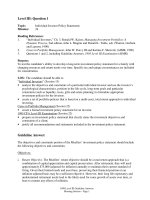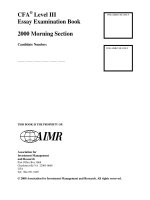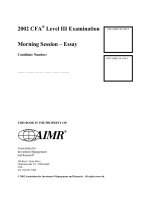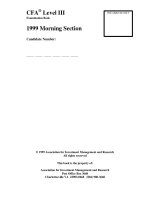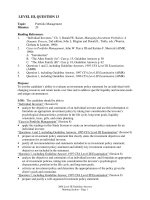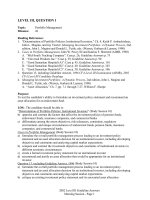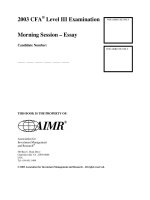L3 mock sample exam CFA level III essay questions 2013
Bạn đang xem bản rút gọn của tài liệu. Xem và tải ngay bản đầy đủ của tài liệu tại đây (240.06 KB, 80 trang )
Level III
Page 1
The Morning Session of the 2013 Level III CFA® Examination has 11 questions.
For grading purposes, the maximum point value for each question is equal to the
number of minutes allocated to that question.
Question
1
2
3
4
5
6
7
8
9
10
11
Topic
Minutes
Portfolio Management – Individual
Portfolio Management – Individual
Portfolio Management – Individual/Behavioral
Portfolio Management – Equity
Portfolio Management – Economics
Portfolio Management – Institutional
Portfolio Management – Institutional
Portfolio Management – Fixed Income
Portfolio Management – Fixed Income
Portfolio Management – Risk Management
Portfolio Management – Performance Evaluation
20
15
16
17
20
18
14
17
9
18
16
Total:
180
Page 2
Level III
THIS PAGE INTENTIONALLY LEFT BLANK
ANY MARKS MADE ON THIS PAGE WILL
NOT BE GRADED
Level III
Page 3
QUESTION 1 HAS FOUR PARTS (A, B, C, D) FOR A TOTAL OF 20 MINUTES.
Thomas and Elizabeth Voort, both age 45, are meeting with their financial advisor, Marc Lenard.
Lenard is creating an investment policy statement for the Voorts. Thomas sold his consulting
business at year-end and retired. The Voorts will rely on their investment portfolio to meet
future expenses in excess of Thomas’ retirement income. Elizabeth is not employed. Financial
details include:
Income
Thomas will receive retirement payments of USD 125,000 per year for his lifetime from the
business he sold. The retirement payments are not indexed for future inflation and are fully
taxable as ordinary income.
Expenses
The Voorts’ total living expenses last year were USD 300,000, and they are expected to grow
each year at the inflation rate. Taxes are due immediately on the gain from the sale of the
business at a rate of 15%. The Voorts do not expect any other significant cash outflows in the
future.
The tax rate on ordinary income and all investment returns is 30%. The inflation rate is expected
to be 2.5% per year.
Assets
The Voorts own their home, valued at USD 1,250,000, mortgage-free. They have a taxable
investment portfolio with a current market value of USD 2,500,000. This portfolio has no
previous tax liability due in the coming year. Thomas received a lump-sum USD 10,000,000
payment from the sale of his business; his cost basis is zero. The net proceeds of the sale will be
added to the Voorts’ investment portfolio. Their goals are to grow the asset base of the portfolio
over time to maintain its after-tax purchasing power and to establish and maintain a cash reserve
of USD 250,000.
A.
Determine the Voorts’ nominal after-tax required rate of return for the coming year.
Show your calculations.
(8 minutes)
B.
State two reasons why the Voorts’ ability to assume risk in their investment portfolio is
above average.
(4 minutes)
C.
Determine the Voorts’ liquidity requirement (in USD) for the coming year. Show your
calculations.
(3 minutes)
Two years later, the Voorts ask Lenard to construct a new long-term strategic asset allocation
with a more aggressive goal of achieving at least 3.5% annualized growth in the after-tax
Page 4
Level III
purchasing power of the portfolio. They indicate that the portfolio should have only a small
probability of declining more than 10% in nominal pre-tax terms in any one year. Lenard
explains to the Voorts that a normal distribution can be used to model the portfolio returns. The
Voorts agree to use a two-standard-deviation approach to monitor the shortfall risk of the
portfolio.
Expected inflation remains 2.5% per year and the tax rate remains 30%. Based on his current
market outlook, Lenard considers three potential portfolio allocations for the Voorts as shown in
Exhibit 1.
Asset Class
Stocks
Bonds
Cash
Exhibit 1
Potential Long-Term Strategic Portfolios
Expected
Portfolio Portfolio
Annual
X
Y
Return
11.0%
70%
55%
6.0%
25%
35%
2.5%
5%
10%
Pre-tax expected return (nominal)
Expected standard deviation (nominal)
D.
9.3%
11.0%
Portfolio
Z
8.4%
8.7%
60%
35%
5%
8.8%
9.3%
Determine the most appropriate portfolio from Exhibit 1 for the Voorts, given their
objectives and constraints. Justify your response with two reasons.
(5 minutes)
ANY MARKS MADE ON THIS PAGE WILL
NOT BE GRADED
Level III
Answer Question 1 on This Page
Page 5
CFA INSTITUTE
USE ONLY
1
Page 6
CFA INSTITUTE
USE ONLY
1
Level III
Answer Question 1 on This Page
Level III
Answer Question 1 on This Page
Page 7
CFA INSTITUTE
USE ONLY
1
Page 8
CFA INSTITUTE
USE ONLY
1
Level III
Answer Question 1 on This Page
Level III
Answer Question 1 on This Page
Page 9
CFA INSTITUTE
USE ONLY
1
Page 10
CFA INSTITUTE
USE ONLY
1
Level III
Answer Question 1 on This Page
Level III
Answer Question 1 on This Page
Page 11
CFA INSTITUTE
USE ONLY
1
Page 12
Level III
THIS PAGE INTENTIONALLY LEFT BLANK
ANY MARKS MADE ON THIS PAGE WILL
NOT BE GRADED
Level III
Page 13
QUESTION 2 HAS FOUR PARTS (A, B, C, D) FOR A TOTAL OF 15 MINUTES.
Gerardo Puente, age 70, is a retired entrepreneur with a desire for privacy in his financial affairs.
His wife is 45 years old and they have three young sons. Puente has one daughter from a
previous marriage.
The Puentes live in a country that is a community property regime with the U.S. dollar as its
currency. The community property regime entitles a surviving spouse to receive a one-half
interest in assets accumulated during the marriage. Puente’s total estate has grown from
USD 12 million to USD 26 million during his current marriage. The forced heirship rules in
Puente’s country entitle his current wife to receive a minimum of 25% of the total estate and all
children to equally share a minimum of 25% of the total estate.
Puente would like to secure a sound financial future for his family. He worries about potential
legal claims from outside the family and disputes among his children. As a result, Puente
consults his investment advisor, who recommends that Puente establish a trust.
A.
Determine the minimum amount that Puente’s current wife would be entitled to receive,
before estate taxes are considered, if he were to die today. Show your calculations.
(4 minutes)
B.
Discuss two benefits, specific to Puente’s circumstances, of establishing a trust.
(4 minutes)
Puente’s daughter from his previous marriage is 30 years old. Her income tax rate is lower than
Puente’s. Puente asks his investment advisor about the tax benefit of making a current gift to his
daughter rather than transferring wealth to her through a bequest upon his death. The country’s
gift tax rate is flat, with no annual or lifetime exemptions. The estate tax rate is also flat and
equal to the gift tax rate. The laws of the country require the donor to pay any gift taxes. The
investment advisor makes the following assumptions:
C.
Puente’s estate will be subject to estate tax.
His daughter’s estate will not be taxed because its value will be below the
minimum taxable threshold.
His daughter’s pre-tax investment returns on any gifted assets will be equal to
Puente’s.
Justify with two reasons why tax considerations favor Puente making a current gift to
his daughter rather than transferring wealth to her upon his death.
Note: No calculations are required.
(4 minutes)
Page 14
Level III
Five years have passed and Puente’s daughter now has a three-year-old son who is Puente’s only
grandchild. Puente believes he has USD 1 million of excess capital that could be transferred to
his grandson. Due to a change in financial circumstances, the investment advisor now assumes
that Puente’s daughter’s estate will be subject to estate tax.
D.
Explain the tax benefit of a direct transfer of assets from Puente to his grandson.
Note: No calculations are required.
(3 minutes)
ANY MARKS MADE ON THIS PAGE WILL
NOT BE GRADED
Level III
Answer Question 2 on This Page
Page 15
CFA INSTITUTE
USE ONLY
2
Page 16
CFA INSTITUTE
USE ONLY
2
Level III
Answer Question 2 on This Page
Level III
Answer Question 2 on This Page
Page 17
CFA INSTITUTE
USE ONLY
2
Page 18
CFA INSTITUTE
USE ONLY
2
Level III
Answer Question 2 on This Page
Level III
Answer Question 2 on This Page
Page 19
CFA INSTITUTE
USE ONLY
2
Page 20
Level III
QUESTION 3 HAS THREE PARTS (A, B, C) FOR A TOTAL OF 16 MINUTES.
Joyce Siosan is a 42-year-old lawyer at a prestigious law firm. She is meeting with Joel Murray,
a financial advisor, to organize her finances. During the interview process, Siosan tells Murray
that she has been purchasing short-term, out-of-the-money call and put options. Siosan
acknowledges these options have a low probability of paying off and that the expected return
from her options trading is negative. However, she states that she is attracted by the possibility
of high returns when she can exercise in-the-money options. At the same time, Murray notes
that Siosan has been purchasing low-payoff earthquake insurance on her home, which is located
in a low-probability earthquake zone.
A.
Describe Siosan’s utility function. Contrast her utility function with that assumed in
traditional finance theory.
(5 minutes)
Siosan purchases a new luxury vehicle every two years and takes expensive annual vacations.
She has a reputation for paying the entire bill at the upscale restaurants where she dines regularly
with her friends. Siosan’s annual consumption, options trading, and housing expenditures are
paid for entirely out of her salary income and half of her modest annual bonus. She deposits the
other half of her annual bonus and any other non-salary sources of income into her relatively
small retirement account, which excludes her options trading. Siosan is reluctant to incur debt
and has only a small mortgage on her home, despite the fact that she will soon be made a partner
in her firm and will have much higher earnings. Murray believes that Siosan exhibits behavioral
biases that interfere with an optimal savings and consumption allocation. In particular, he thinks
that she is not saving enough for retirement.
ANSWER QUESTION 3-B IN THE TEMPLATE PROVIDED ON PAGES 22 AND 23.
B.
Discuss how Siosan’s behavior reflects the bias of:
i.
ii.
self-control.
mental accounting.
Explain how a rational economic individual in traditional finance would behave
differently with respect to each bias.
(6 minutes)
Siosan’s retirement portfolio is allocated 50% to money-market securities and 50% to a few
speculative stocks that she read about in an investment newsletter. Murray observes that
Siosan’s retirement portfolio allocation is consistent with Behavioral Portfolio Theory and not
consistent with a mean–variance framework.
C.
Determine whether Murray’s observation about Siosan’s retirement portfolio allocation
is correct. Justify your response with two reasons.
(5 minutes)
Level III
Answer Question 3 on This Page
Page 21
CFA INSTITUTE
USE ONLY
3
Page 22
Level III
Answer Question 3 on This Page
Template for Question 3-B
Behavioral
bias
Discuss how Siosan’s behavior reflects
each bias.
i. self-control
Template for Question 3-B continued on page 23
Explain how a rational economic
individual in traditional finance
would behave differently with respect
to each bias.
Level III
Page 23
Answer Question 3 on This Page
Template for Question 3-B (continued)
Behavioral
bias
ii. mental
accounting
Discuss how Siosan’s behavior reflects
each bias.
Explain how a rational economic
individual in traditional finance
would behave differently with respect
to each bias.
Page 24
CFA INSTITUTE
USE ONLY
3
Level III
Answer Question 3 on This Page
Level III
Answer Question 3 on This Page
Page 25
CFA INSTITUTE
USE ONLY
3
